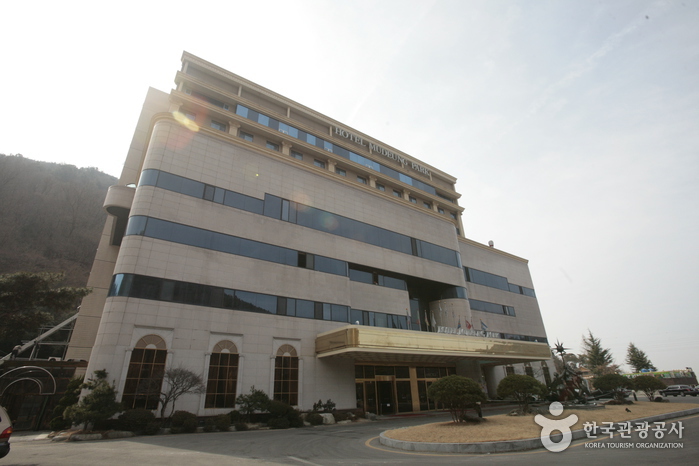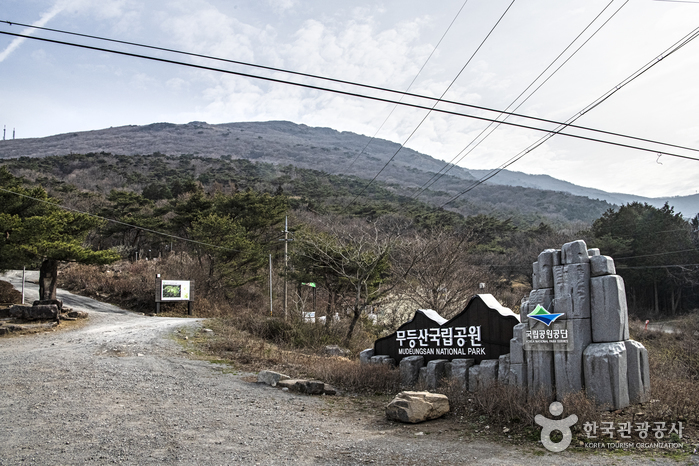Maru-o [Korea Quality] / 마루 O(MARU-O) [한국관광 품질인증]
13.3Km 2020-12-12
5-8, Baemet 3-gil, Naju-si, Jeollanam-do
+82-61-331-0700
MARU O is a modern business hotel located at the center of Naju Innovation City. Many public enterprises are clustered around the hotel. Therefore, the hotel is loved by business travelers visiting the city, while the neat facilities also attract casual travelers. The Bitgaram Lake Park, right in front of the hotel, is a great place for a walk along the pleasant park surrounding a small lake. At the heart of the park stands Baemesan Observatory where one can enjoy an unhindered view of Naju Innovation City.
The hotel offers a variety of services as well. In particular, there is a charger for electric car drivers in the underground parking lot. Front desk provides tourist guidebooks on Naju and the Jeollanam-do region and lends mobile phone charger for free.
MARU O is about a 12-minute drive away from the KTX Naju Station, and 15 minutes by car from the inter-city bus terminal, Yeongsanpo Hongeo Street or Naju Gomtang Street. In particular, Naju Gomtang Street is a region where famous Gomtang (Naju’s representative food) restaurants are concentrated. As Hayanjib, Naju Gomtang Noamjib, Naju Gomtang Wonjojib and 60-year Nampyeong Halmaejib (some of the best known places) are all found here, just drop in anywhere and you will be able to taste the authentic taste of local dishes.
Hotel Mudeung Park (무등파크호텔)
13.6Km 2021-02-01
14-10, Jiho-ro 164beon-gil, Dong-gu, Gwangju
+82-62-226-0011
Opened in 2004, Hotel Mudeung Park is located at the foot of Mudeungsan Mountain. Situated in a leisure town measuring an impressive 495,000 m², the hotel is one of the representative hotels of Gwangju and is known for its high-quality facilities and services.
In addition to its posh guestrooms, Hotel Mudeung Park offers a myriad of facilities including a convention hall, a banquet hall, a business center, restaurants, a wine bar, a driving range, a bowling alley, and an observatory with a panoramic view of downtown Gwangju.
Telesilla y Monorraíl del Monte Mudeungsan (Complejo Recreativo Jisan) (무등산 리프트모노레일 (지산유원지))
13.6Km 2025-06-16
Jiho-ro 164-beongil 14-10, Dong-gu, Gwangju
Parque Nacional del Monte Mudeungsan (무등산국립공원)
13.7Km 2023-11-14
Dongsan-gil 29, Dong-gu, Gwangju.
El Parque Nacional del Monte Mudeungsan es una montaña en el linde de Hwasun-gun, Damyang-gun y Gwangju, y se convirtió en parque provincial en 1972. También se le refiere como monte Muaksan, monte Mujinaksan o monte Seoseoksan. Mudeungsan tiene 1.186 m sobre el nivel del mar, y la cima presenta tres picos rocosos, llamados: Cheonwongbong, Jiwongbong e Inwonbong, también conocidos como los “Tres Jeongsang".
Mudeungsan no tiene una pendiente inclinada, así que cualquiera puede escalarla fácilmente, y tiene hermosos valles que discurren bajo ella. Una gran diversidad de rocas ocupan el pico Cheonwongbong, y, debido a esto, otrora fue objeto de culto por la gente local como una montaña divina. Entre las más majestuosas de estas rocas están: las rocas Seoseokdae, Gyubong e Ipseokdae. En la base de la montaña, hay templos famosos, tales como: los templos Yaksa-am, Jeungsimsa y Wonhyosa. Mudeungsan también es conocida por su belleza durante todas las estaciones del año. En el otoño, las hojas otoñales de Gyubongam son especialmente hermosas, y la hierba de eoksae (tipo de junco asiático) de la cresta Baekma se vuelve espectacular. En invierno, la nieve y el hielo de las montañas crean también un paisaje exquisito.
Bajo la montaña, hay varias instalaciones recreativas y de conveniencia para hacer su visita más placentera. El Museo Nacional de Gwangju es una de ellas, un edificio al estilo coreano tradicional, con espacios de exposición y una amplia instalación para la conservación de reliquias. Tiene exhibiciones de tesoros encontrados en el mar de Sinan, tales como reliquias de las dinastías Song y Won de China, además de reliquias de la provincia de Honam durante los períodos Seonsa, Baekje y Silla, y pinturas del período Joseon. Son en total unas 2.000 reliquias.
Complejo Recreativo Jisan (지산유원지)
13.8Km 2025-06-16
Jiho-ro 164-beongil 23, Dong-gu, Gwangju
3917 Majung [Korea Quality] / 3917 마중 [한국관광 품질인증/Korea Quality]
13.9Km 2023-04-13
42-16, Hyanggyo-gil, Naju-si, Jeollanam-do
Located in Gyo-dong, Naju-si, Jeollanam-do, 3917 Majung is a cultural space combining a hanok (traditional Korean house) cafe, modern cultural experiences, and hanok guesthouse. The name “3917 Majung” refers to its goal of “welcoming (majung) the modern culture of Naju in 1939 anew in the year 2017.” Spread out on a wide land area of 13,223 m2 are four buildings of Nanpajeong, Sarangchae, Mokseowon, and Siseoheon. All buildings take after the unique combination of Japanese- and Western-style housing commonly seen in the late Korean Empire period.
Nanpajeong is a pavilion constructed during mid-Joseon period, named after its most famous guest Jeong Seok-jin (pen-name: Nanpa), a scholar who led an uprising against Japanese imperialism in late Joseon period. There are two ondol (under-the-floor heating system) rooms in total, separated by a central wooden-floor hall (daecheong), one supporting 3 to 4 guests, one ideal for 2 to 3 guests. The restroom, which is also fitted with a shower booth, is located outside the building.
Eunhaengmok Room 1 and 2, which are housed in the Sarangchae building, are tatami rooms with balcony. Sarangchae’s shower and restroom is located in the building. Mokseowon is likewise made up of three tatami rooms, separated by open floor space and an attic. The shower and restroom is located outside the building. Siseoheon houses a 4-person room and the largest room in the complex, capable of supporting more than 10 guests. There are 2 restrooms and 2 restrooms with shower facilities, making the building ideal for group events.
Estación de Naju (나주역)
15.5Km 2021-04-09
Najuyeok-ro 56, Naju-si, Jeollanam-do.
La Estación de Naju forma parte de la línea Honam que recorre por la región de Jeolla-do. La estación se localiza en Songwol-dong, de la ciudad de Naju, en la provincia de Jeollanam-do.
La antigua Estación de Naju, localizada en Jungnim-dong, fue el punto de inicio del Movimiento de la Independencia de los estudiantes de Gwangju en 1929, que empezó como resultado de los conflictos entre estudiantes coreanos y japoneses que solían llegar a Gwangju en tren. Este significado histórico hizo retrasar la relocalización de la Estación de Naju. Con la apertura parcial de la línea Honam, el día 10 de julio de 2001, la Estación de Naju se integró con la Estación de Yeongsanpo y se trasladó a su actual ubicación enfrente del Ayuntamiento de Naju. Las instalaciones de la antigua Estación de Naju eran demasiado viejas y el edificio empezaba a ser pequeño para dar cabida al número de pasajeros de la región, por lo que fue la Estación de Yeongsanpo la que empezó a cubrir la demanda de pasajeros.
Después de la integración de las dos estaciones, todos los trenes regulares en la línea Honam, así como algunos de los trenes de alta velocidad, hacen parada en la Estación de Naju.
Sane Flower [Korea Quality] / (주)산에는 꽃이피네 [한국관광 품질인증]
15.8Km 2020-09-03
20-1, Dongnyeok-gil, Dado-myeon, Naju-si, Jeollanam-do
+82-10-4612-4232
‘Flowers Blossoms in the Mountains’ is a hanok-style accommodation located between the House of Hong Gi-chang, a local cultural heritage, and Gyeeun Historic House (or the House of Hong Gi-eung; National Folklore Cultural Heritage No. 151) in Dorae Hanok Village. Built in 1917, the house was built with carefully selected high-quality wooden materials without using nails. It was renovated for use as tourist accommodation in 2011, opened as a hanok style of accommodation in 2013, and renovated again in 2014. On this occasion, the old doors were replaced and made into the tables that stand in the grassy courtyard.
The house has a total of 4 rooms. Each room can accommodate up to 2 to 4 people. Each room is equipped with a kitchen, bathroom, air-conditioner, TV, toiletries, plates, and so on.
This well-insulated hanok house is decorated with hanji (traditional Korean paper handmade from mulberry tree) and various antique items. Tables are available for guests in the courtyard, of which a stylish stone-paved corner stands out in particular.
There is a walkway established by Naju City in front of the house, and a vegetable garden near the house. Guests can see gourds and sponge gourds in the yard and acorn trees on the hill behind the house. In addition, the Metasequoia Street that runs through the grounds of the Naju Forest Resource Institute is just one minute’s drive from the house.
Moreover, as the village contains many houses that are classed as cultural heritages, the owner guides guests around them at weekends. Surrounding tourist attractions include Bulhoesa Temple and Najuhyanggyo Confucian School.
Doraemi House (도래미)
15.9Km 2025-05-22
18-26, Dongnyeok-gil, Naju-si, Jeollanam-do
Monumento Chungjangsa (충장사)
16.6Km 2023-02-09
Songgang-ro 13, Buk-gu, Gwangju
![Maru-o [Korea Quality] / 마루 O(MARU-O) [한국관광 품질인증]](http://tong.visitkorea.or.kr/cms/resource/14/2593514_image2_1.jpg)



![3917 Majung [Korea Quality] / 3917 마중 [한국관광 품질인증/Korea Quality]](http://tong.visitkorea.or.kr/cms/resource/24/2706124_image2_1.jpg)
![Sane Flower [Korea Quality] / (주)산에는 꽃이피네 [한국관광 품질인증]](http://tong.visitkorea.or.kr/cms/resource/98/2574998_image2_1.jpg)
 Español
Español
 한국어
한국어 English
English 日本語
日本語 中文(简体)
中文(简体) Deutsch
Deutsch Français
Français Русский
Русский